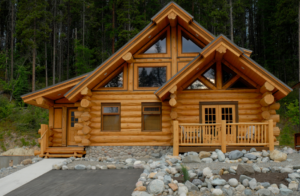 When you are home, do you want to have the same feeling as though you were on vacation? Log homes offer a unique aesthetic that can bring a touch of rustic charm to any location. Log homes are not limited to mountain settings and can be found in cities and towns across the country.
When you are home, do you want to have the same feeling as though you were on vacation? Log homes offer a unique aesthetic that can bring a touch of rustic charm to any location. Log homes are not limited to mountain settings and can be found in cities and towns across the country.
During the National Log Home Open House in July, members of the National Association of Home Builders’ Log Homes Council are inviting Americans to experience log home living by hosting model home tours, log raising demonstrations, factory tours, seminars and more.
Modernity. Even though the exterior of your log cabin may be steeped in history, that doesn’t mean your interior has to be. Today’s log homes feature the same modern amenities as traditional homes, including open floor plans, media rooms, master suites, and garages.
They are also known for their exceptional craftsmanship, which can include handcrafted staircases and cathedral ceilings. Combining modernity with old-World charm will make you feel as though you are escaping to another world.
Sustainability. If you are under the assumption that a log home is a leaky, drafty energy guzzler, you may need to reconsider your assumption; log homes can be surprisingly energy-efficient. The wood in the logs act as a natural insulator due to their high thermal mass and low conductivity, helping to regulate indoor temperatures and reduce energy costs.
According to the National Bureau of Standards, log homes reduce energy needs by 30% when compared to traditional stick framed homes. Additionally, many log home builders use eco-friendly materials to build and practice sustainable building methods and are in compliance with the NAHB’s National Green Building Standard.
Durability. Log homes are known for their durability, with some in Europe standing for more than 800 years. The solid wood construction also provides excellent soundproofing qualities. Additionally, an interesting fact that many people find surprising is that log homes are more fire resistant than “regular” houses. Many people think the opposite would be true, which makes sense given the materials and look of log homes. However, the reason log homes are more fire resistant is because the size and diameter of the logs that are used make them harder for fires to use as fuel. Unlike “normal” framing, the fire cannot wrap around the logs as it would with traditional 2x4s.
think the opposite would be true, which makes sense given the materials and look of log homes. However, the reason log homes are more fire resistant is because the size and diameter of the logs that are used make them harder for fires to use as fuel. Unlike “normal” framing, the fire cannot wrap around the logs as it would with traditional 2x4s.
To learn more about the benefits of a log home, contact your local home builders association HERE.